A Multi-Scale Study on the Property Degradation of High-Temperature Treated Beishan Granite
Abstract
1. Introduction
2. Experiments
2.1. Beishan Granite Sample
2.2. Experimental Studies
2.2.1. High-Temperature Treatment Test
2.2.2. Physical Property Tests
2.2.3. Mechanical Property Tests
3. Constitutive Model
3.1. Damage Constitutive Model under Normal Temperature Loading
3.2. High-Temperature Damage Constitutive Model
4. Solution of Constitutive Equation
4.1. K and m
4.2. A and B
5. The Evolution of Thermal Damage in Beishan Granites
6. PFC-Based High-Temperature Damage Simulation
7. Conclusions
- The mass, volume, density, wave velocity, elastic modulus, peak stress, and other experimental results of Beishan granite were obtained. They indicate that temperature has a significant effect on physical and mechanical properties. The high temperature not only gives rise to microcracks between grains but also penetration cracks when the phase change point of quartz is reached. Among these, the microcracks initiate and expand rapidly. High temperature reduces the strength and brittleness of rock.
- The mechanical model is assumed to consist of a Kelvin body and a damaged body in parallel. Based on the damage theory, the Weibull distribution, the Lemaitre strain equivalence assumption, the damage threshold, and the residual strength, this study innovatively modified the D–P criterion and damage stress. The constitutive model of thermally damaged Beishan granite. The solution of the parameters in the constitutive model was proposed. It was found that the Weibull distribution parameters K and m have significant influences on the curve trend. The theoretical study has produced results essentially in agreement with the experimental ones. The parameters required for the model are conventional mechanical parameters that can be calculated from the uniaxial test results, thus making the model convenient to apply.
- In fact, the variation of stress-strain curves of rocks under different treatment temperatures is complex. Since rock is non-homogeneous material, there will be certain differences in the properties of specimens used for different temperature levels, which may cause dispersion of the experimental results. Parameters such as K, m, A, and B in the proposed constitute model highly depend on the experimental results. Therefore, it is difficult to define temperature-dependent expressions for them. A constitutive equation that can accurately describe the stress-strain relationship of rock with temperature as the unique variable will be an important research direction. The following work will be conducted from the aspects of specimen preparation, selection, test conditions, test methods, and equation derivation.
- According to the simulation of PFC, there are two main types of rock cracks: shear cracks and tensile cracks. The cracks change from mainly tensile cracks to mainly shear cracks with increasing temperature. A higher temperature implies a more significant effect of shear cracking and a higher degree of damage.
Author Contributions
Funding
Institutional Review Board Statement
Informed Consent Statement
Data Availability Statement
Acknowledgments
Conflicts of Interest
References
- Wang, J. Progress of Geological Disposal of High–level Radioactive Waste in China in the 21th Century. At. Energy Sci. Technol. 2019, 53, 2072–2082. [Google Scholar]
- Wang, R.; Zhuo, Z.; Zhou, H.W.; Liu, J.F. A fractal derivative constitutive model for three stages in granite creep. Results Phys. 2017, 7, 2632–2638. [Google Scholar] [CrossRef]
- Rechard, R.P. Historical background on performance assessment for the Waste Isolation Pilot Plant. Reliab. Eng. Syst. Saf. 2000, 69, 5–46. [Google Scholar] [CrossRef]
- Goldstein, J. How to build a better sepulcher: Lessons from New Mexico’s Waste Isolation Pilot Plant. Bull. At. Sci. 2011, 67, 77–88. [Google Scholar] [CrossRef]
- Sasaki, T.; Rutqvist, J. Effects of time-dependent deformation of shale on the integrity of a geological nuclear waste repository. Int. J. Rock Mech. Min. Sci. 2022, 158, 105206. [Google Scholar] [CrossRef]
- Chang, K.W.; Nole, M.; Stein, E.R. Reduced-order modeling of near-field THMC coupled processes for nuclear waste repositories in shale. Comput. Geotech. 2021, 138, 104326. [Google Scholar] [CrossRef]
- Li, L.; Shu, X.; Cheng, Y.; Wen, M.; Zhou, H.; Lu, X.; Lu, Y.; Chen, J.; Dong, F. High immobilizing capacity of natural granite as glass-ceramic matrix to simulated trivalent actinide waste. Radiat. Phys. Chem. 2022, 195, 110067. [Google Scholar] [CrossRef]
- Gautam, P.K.; Verma, A.K.; Singh, T.N.; Hu, W.; Singh, K.H. Experimental investigations on the thermal properties of Jalore granitic rocks for nuclear waste repository. Thermochim. Acta 2019, 681, 178381. [Google Scholar] [CrossRef]
- Hudson, J.A.; Bäckström, A.; Rutqvist, J.; Jing, L.; Backers, T.; Chijimatsu, M.; Christiansson, R.; Feng, X.T.; Kobayashi, A.; Koyama, T.; et al. Characterising and modelling the excavation damaged zone in crystalline rock in the context of radioactive waste disposal. Environ. Geol. 2009, 57, 1275–1297. [Google Scholar] [CrossRef]
- Tsang, C.F.; Bernier, F.; Davies, C. Geohydromechanical processes in the Excavation Damaged Zone in crystalline rock, rock salt, and indurated and plastic clays—In the context of radioactive waste disposal. Int. J. Rock Mech. Min. Sci. 2005, 42, 109–125. [Google Scholar] [CrossRef]
- Rutqvist, J.; Börgesson, L.; Chijimatsu, M.; Hernelind, J.; Jing, L.; Kobayashi, A.; Nguyen, S. Modeling of damage, permeability changes and pressure responses during excavation of the TSX tunnel in granitic rock at URL, Canada. Environ. Geol. 2009, 57, 1263–1274. [Google Scholar] [CrossRef]
- Cai, Y.; Liu, Y. Geometry Parameter Analysis on the Fracture Nterconnectivity of Rock Mass Surrounding Nuclear Waste Repositories. J. Geol. Hazards Environ. Preserv. 2001, 33, 39–47. [Google Scholar]
- Laverov, N.P.; Yudintsev, S.V.; Kochkin, B.T.; Malkovsky, V.I. The Russian Strategy of using Crystalline Rock as a Repository for Nuclear Waste. Elements 2016, 12, 253–256. [Google Scholar] [CrossRef]
- Hadermann, J.; Heer, W. The Grimsel (Switzerland) migration experiment: Integrating field experiments, laboratory investigations and modelling. J. Contam. Hydrol. 1996, 21, 87–100. [Google Scholar] [CrossRef]
- Fairhurst, C. Nuclear waste disposal and rock mechanics: Contributions of the Underground Research Laboratory (URL), Pinawa, Manitoba, Canada. Int. J. Rock Mech. Min. Sci. 2004, 41, 1221–1227. [Google Scholar] [CrossRef]
- WNA. World Nuclear Performance Report 2022. Available online: https://www.world-nuclear.org/world-nuclear-performance-report.aspx (accessed on 1 November 2022).
- Chen, L.; Wang, C.P.; Liu, J.F.; Li, Y.; Liu, J.; Wang, J. Effects of temperature and stress on the time-dependent behavior of Beishan granite. Int. J. Rock Mech. Min. Sci. 2017, 93, 316–323. [Google Scholar] [CrossRef]
- Heierli, J. A comparative study of engineering options for the disposal of high-level radioactive waste with regard to thermal effects and chemical degradation. J. Nucl. Sci. Technol. 2016, 53, 1276–1295. [Google Scholar] [CrossRef]
- Takarli, M.; Prince, W.; Siddique, R. Damage in granite under heating/cooling cycles and water freeze–thaw condition. Int. J. Rock Mech. Min. Sci. 2008, 45, 1164–1175. [Google Scholar] [CrossRef]
- Qin, Y.; Tian, H.; Xu, N.X.; Chen, Y. Physical and Mechanical Properties of Granite After High-Temperature Treatment. Rock Mech. Rock Eng. 2020, 53, 305–322. [Google Scholar] [CrossRef]
- Zhang, W.; Sun, Q.; Hao, S.; Geng, J.; Lv, C. Experimental study on the variation of physical and mechanical properties of rock after high temperature treatment. Appl. Therm. Eng. 2016, 98, 1297–1304. [Google Scholar] [CrossRef]
- Zhao, X.G.; Xu, H.R.; Zhao, Z.; Guo, Z.; Cai, M.; Wang, J. Thermal conductivity of thermally damaged Beishan granite under uniaxial compression. Int. J. Rock Mech. Min. Sci. 2019, 115, 121–136. [Google Scholar] [CrossRef]
- Chen, Y.L.; Wang, S.R.; Ni, J.; Azzam, R.; Fernández-steeger, T.M. An experimental study of the mechanical properties of granite after high temperature exposure based on mineral characteristics. Eng. Geol. 2017, 220, 234–242. [Google Scholar] [CrossRef]
- Gautam, P.K.; Verma, A.K.; Jha, M.K.; Sharma, P.; Singh, T.N. Effect of high temperature on physical and mechanical properties of Jalore granite. J. Appl. Geophys. 2018, 159, 460–474. [Google Scholar] [CrossRef]
- Tomás, R.; Cano, M.; Pulgarín, L.F.; Brotóns, V.; Benavente, D.; Miranda, T.; Vasconcelos, G. Thermal effect of high temperatures on the physical and mechanical properties of a granite used in UNESCO World Heritage sites in north Portugal. J. Build. Eng. 2021, 43, 102823. [Google Scholar] [CrossRef]
- Wu, Y.; Li, X.Z.; Huang, Z.; Xue, S. Effect of temperature on physical, mechanical and acoustic emission properties of Beishan granite, Gansu Province, China. Nat. Hazards 2021, 107, 1577–1592. [Google Scholar] [CrossRef]
- Xu, X.L.; Karakus, M. A coupled thermo-mechanical damage model for granite. Int. J. Rock Mech. Min. Sci. 2018, 103, 195–204. [Google Scholar] [CrossRef]
- Liu, W.; Dan, Z.; Jia, Y.; Zhu, X. On the Statistical Damage Constitutive Model and Damage Evolution of Hard Rock at High-Temperature. Geotech. Geol. Eng. 2020, 38, 4307–4318. [Google Scholar] [CrossRef]
- Wang, F.; Konietzky, H. Thermo-Mechanical Properties of Granite at Elevated Temperatures and Numerical Simulation of Thermal Cracking. Rock Mech. Rock Eng. 2019, 52, 3737–3755. [Google Scholar] [CrossRef]
- Wang, S.; Liao, H.; Chen, Y.; Fernández-Steeger, T.M.; Du, X.; Xiong, M.; Liao, S. Damage Evolution Constitutive Behavior of Rock in Thermo-Mechanical Coupling Processes. Materials 2021, 14, 7840. [Google Scholar] [CrossRef]
- Xie, S.; Han, Z.; Chen, Y.; Wang, Y.; Zhao, Y.; Lin, H. Constitutive modeling of rock materials considering the void compaction characteristics. Arch. Civ. Mech. Eng. 2022, 22, 60. [Google Scholar] [CrossRef]
- Zhao, F.; Sun, Q.; Zhang, W. Fractal analysis of pore structure of granite after variable thermal cycles. Environ. Earth Sci. 2019, 78, 677. [Google Scholar] [CrossRef]
- Miao, S.; Pan, P.Z.; Zhao, X.; Shao, C.; Yu, P. Experimental Study on Damage and Fracture Characteristics of Beishan Granite Subjected to High-temperature Treatment with DIC and AE Techniques. Rock Mech. Rock Eng. 2021, 54, 721–743. [Google Scholar] [CrossRef]
- Li, Q.; Li, X.; Yin, T. Factors affecting pore structure of granite under cyclic heating and cooling: A nuclear magnetic resonance investigation. Geothermics 2021, 96, 102198. [Google Scholar] [CrossRef]
- Wang, F.; Konietzky, H. Thermal damage evolution of granite under slow and high-speed heating conditions. Comput. Geotech. 2020, 123, 103590. [Google Scholar] [CrossRef]
- Liu, L.; Li, H.; Li, X.; Zhang, G.; Wu, R. Research on mechanical properties of heterogeneous rocks using grain-based model under uniaxial compression. Chin. J. Geotech. Eng. 2020, 42, 542–550. [Google Scholar]
- Xie, S.; Han, Z.; Lin, H. A quantitative model considering crack closure effect of rock materials. Int. J. Solids Struct. 2022, 251, 111758. [Google Scholar] [CrossRef]
- Chen, S.; Yang, C.; Wang, G. Evolution of thermal damage and permeability of Beishan granite. Appl. Therm. Eng. 2017, 110, 1533–1542. [Google Scholar] [CrossRef]
- Sun, Q.; Hu, J. Effects of heating on some physical properties of granite, Shandong, China. J. Appl. Geophys. 2021, 193, 104410. [Google Scholar] [CrossRef]
- Wu, Y.; Peng, K.; Zou, Q.; Long, K.; Wang, Y. Tensile Properties and Damage Evolution Laws of Granite After High- and Low-Temperature Cycles. Nat. Resour. Res. 2022, 31, 1289–1306. [Google Scholar] [CrossRef]
- Fang, W.; Jiang, H.; Li, J.; Li, W.; Li, J.; Zhao, L.; Feng, X. A new experimental methodology to investigate formation damage in clay-bearing reservoirs. J. Pet. Sci. Eng. 2016, 143, 226–234. [Google Scholar] [CrossRef]
- Sun, Z.; Jiang, D.; Xie, K.; Wang, K.; Li, L.; Jiang, X. Thermal damage study of Beishan granite based on low field magnetic resonance. J. China Coal Soc. 2020, 45, 1081–1088. [Google Scholar] [CrossRef]
- Wu, Y.; Xi, B.; Wang, L.; Niu, X.; Wang, S.; Zhao, Y. Experimental study on physico-mechanical properties of granite after high temperature. J. Cent. South Univ. Sci. Technol. 2020, 51, 193–203. [Google Scholar]
- Zhao, X.; Meng, W.; Zhou, L. Indentation rolling resistance based on a three-parameter Kelvin solid model. Adv. Mech. Eng. 2019, 11, 1687814019839517. [Google Scholar] [CrossRef]
- Liu, Q.; Xu, X. Damage Analysis of Brittle Rock at High Temperature. Chin. J. Rock Mech. Eng. 2000, 408–411. [Google Scholar]
- Wang, F.; Konietzky, H.; Herbst, M. Influence of heterogeneity on thermo-mechanical behaviour of rocks. Comput. Geotech. 2019, 116, 103184. [Google Scholar] [CrossRef]
- Jiang, H.; Jiang, A.; Yang, X. Statistical damage constitutive model of high temperature rock based on Weibull istribution and its verification. Rock Soil Mech. 2021, 42, 1894–1902. [Google Scholar] [CrossRef]
- Martin, C.D.; Chandler, N.A. The progressive fracture of Lac du Bonnet granite. Int. J. Rock Mech. Min. Sci. Geomech. Abstr. 1994, 31, 643–659. [Google Scholar] [CrossRef]
- Cao, W.; Zhao, H.; Zhang, Y.; Zhang, L. Strain softening and hardening damage constitutive model for rock considering effect of volume change and its parameters determination method. Rock Soil Mech. 2011, 32, 647–654. [Google Scholar]
- Lemaitre, J.; Sermage, J.; Desmorat, R. A two scale damage concept applied to fatigue. Int. J. Fract. 1999, 97, 67. [Google Scholar] [CrossRef]
- Cao, R.; He, S.; Wei, J.; Wang, F. Study of modified statistical damage softening constitutive model for rock considering residual strength. Rock Soil Mech. 2013, 34, 1652–1660+1667. [Google Scholar] [CrossRef]
- Li, T.; Gao, M.; Chen, G.; Ma, C.; Xu, Z.; Yin, H.; Chen, C.; Men, L. A thermal-mechanical-damage constitutive model for hard brittle rocks and its preliminary application. Chin. J. Geotech. Eng. 2017, 39, 1477–1484. [Google Scholar]
- Wang, C.; Chen, L.; Liang, J.; Liu, J.; Liu, Y.; Liu, J.; Wang, J.; Zhou, H. Creep constitutive model for full creep process of granite considering thermal effect. Rock Soil Mech. 2014, 35, 2493–2500+2506. [Google Scholar] [CrossRef]
- Zhu, Z.; Jiang, G.; Tian, H.; Wu, W.; Liang, R.; Dou, B. Study on statistical thermal damage constitutive model of rock based on normal distribution. J. Cent. South Univ. Sci. Technol. 2019, 50, 1411–1418. [Google Scholar]
- Xi, B.; Zhao, Y.; Wan, Z.; Zhao, J.; Wang, Y. Study of Constitutive Equation of Granite Rheological Model with Thermo-Mechanical Coupling Effects. Chin. J. Rock Mech. Eng. 2009, 28, 956–967. [Google Scholar]
- Xu, W.; Zhao, G.; Meng, X.; Cheng, X. Modified D–P criterion based on the double-fold reduction method of the true triaxial single-side unloading strength. Chin. J. Rock Mech. Eng. 2018, 37, 1813–1822. [Google Scholar] [CrossRef]
- Chen, P.; Kong, Y.; Yu, H. Research on the Calibration Method of Microparameters of a Uniaxial Compression PFC2D Model for Rock. Chin. J. Undergr. Space Eng. 2018, 14, 1240–1249. [Google Scholar]
- Huang, Y.H.; Yang, S.Q.; Ranjith, P.G.; Zhao, J. Strength failure behavior and crack evolution mechanism of granite containing pre-existing non-coplanar holes: Experimental study and particle flow modeling. Comput. Geotech. 2017, 88, 182–198. [Google Scholar] [CrossRef]
- Liu, X.; Li, D.; Wang, Z.; Zhang, L. The effect of dry-wet cycles with acidic wetting fluid on strength deterioration of shaly sandstone. Chin. J. Rock Mech. Eng. 2016, 35, 1543–1554. [Google Scholar] [CrossRef]

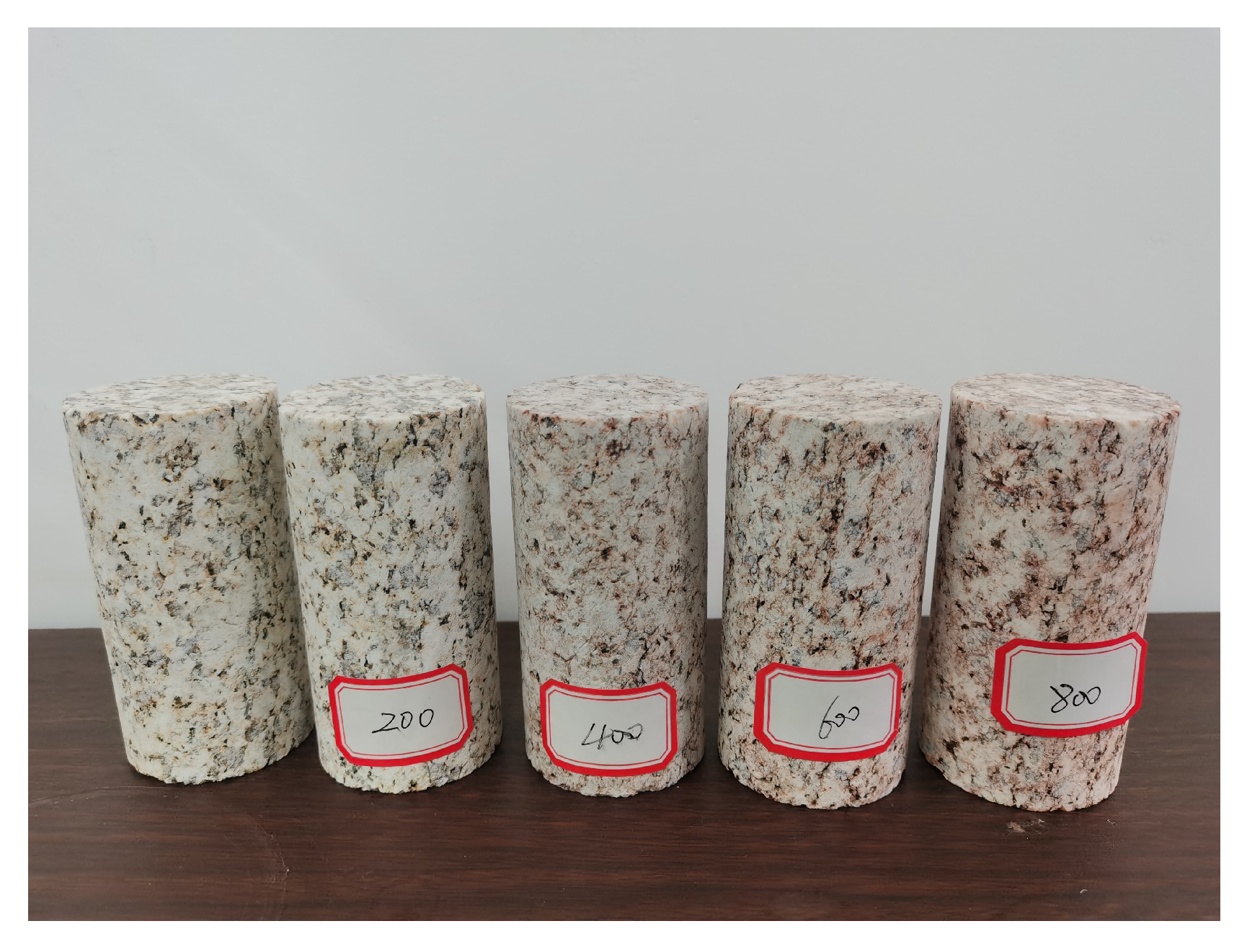
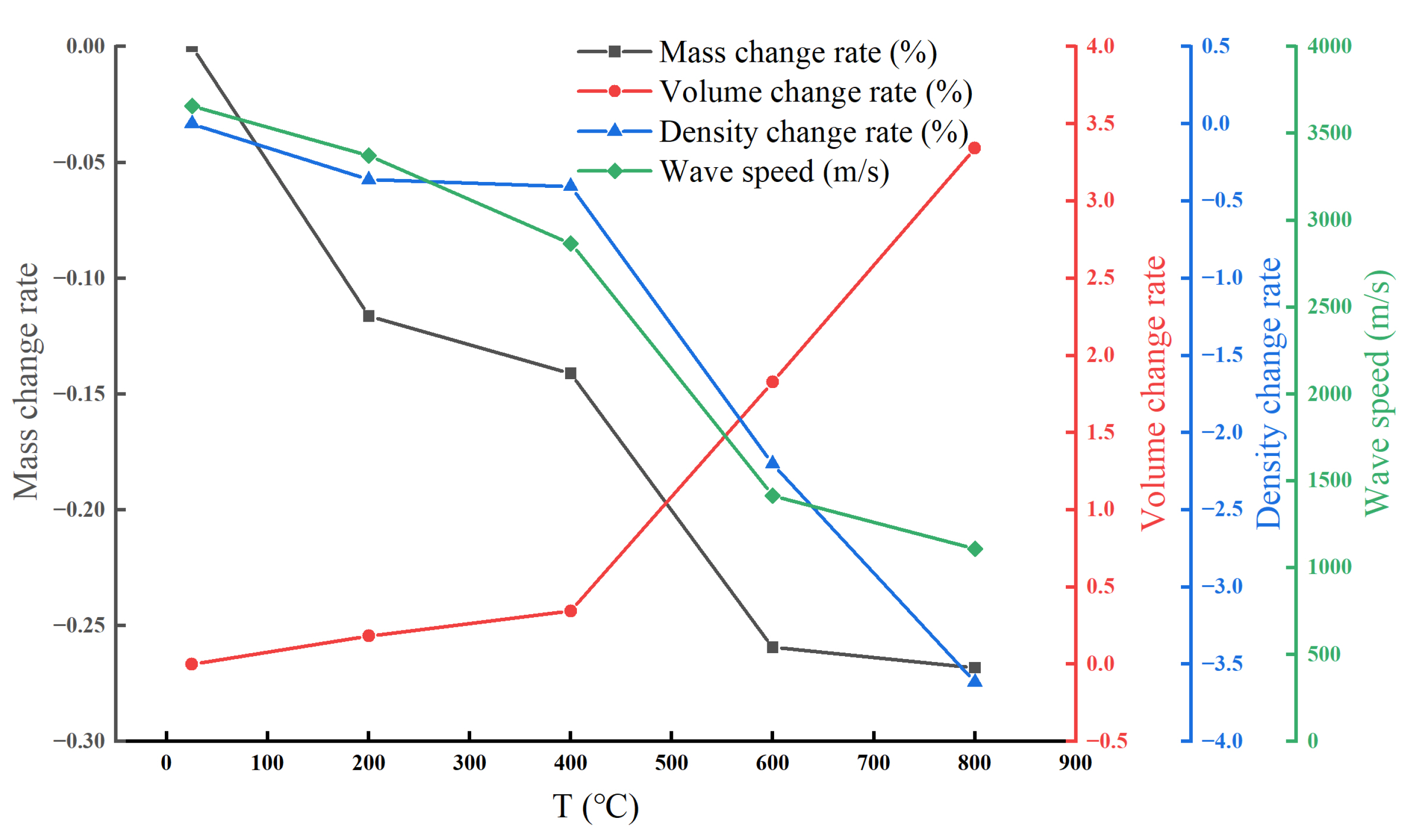
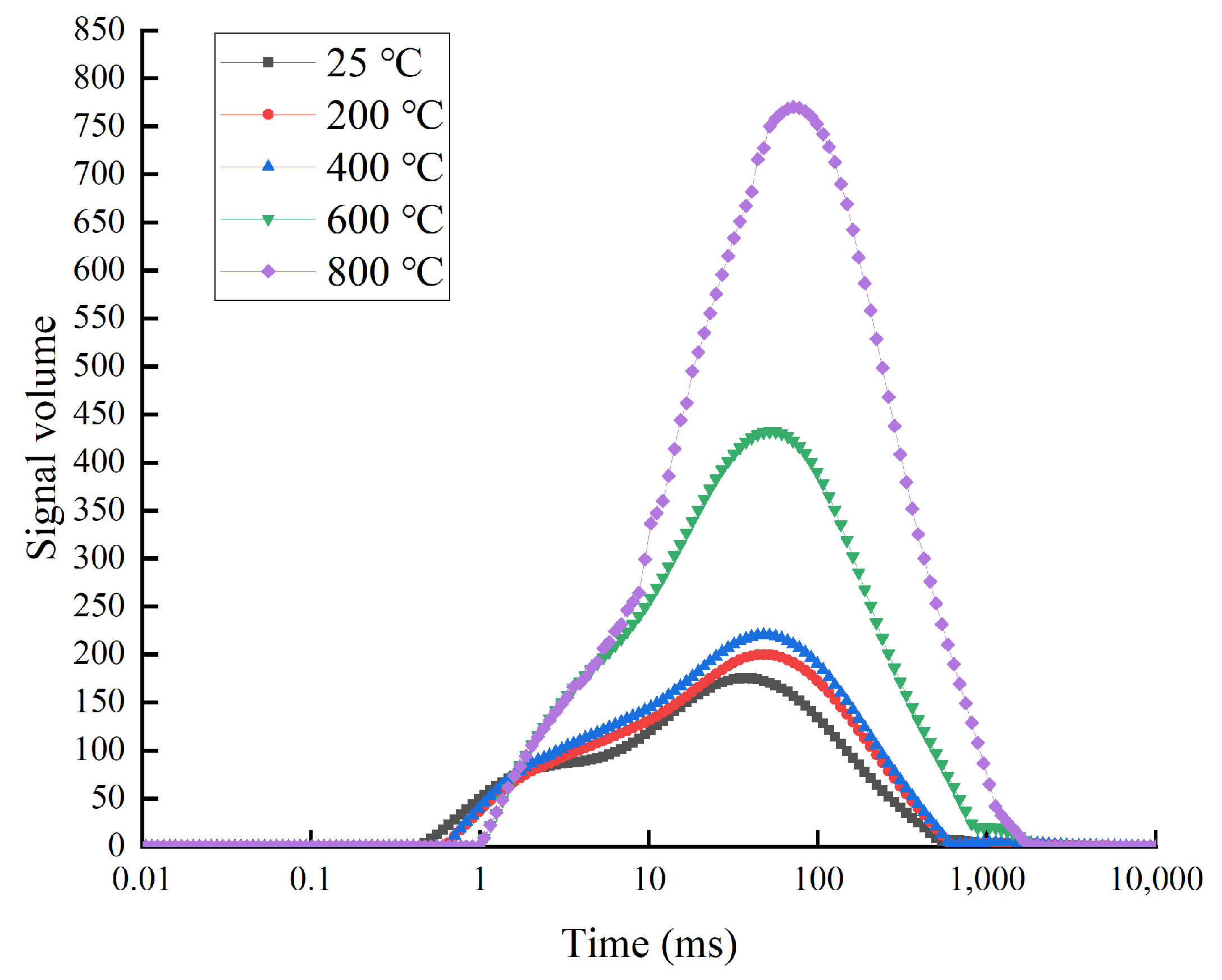
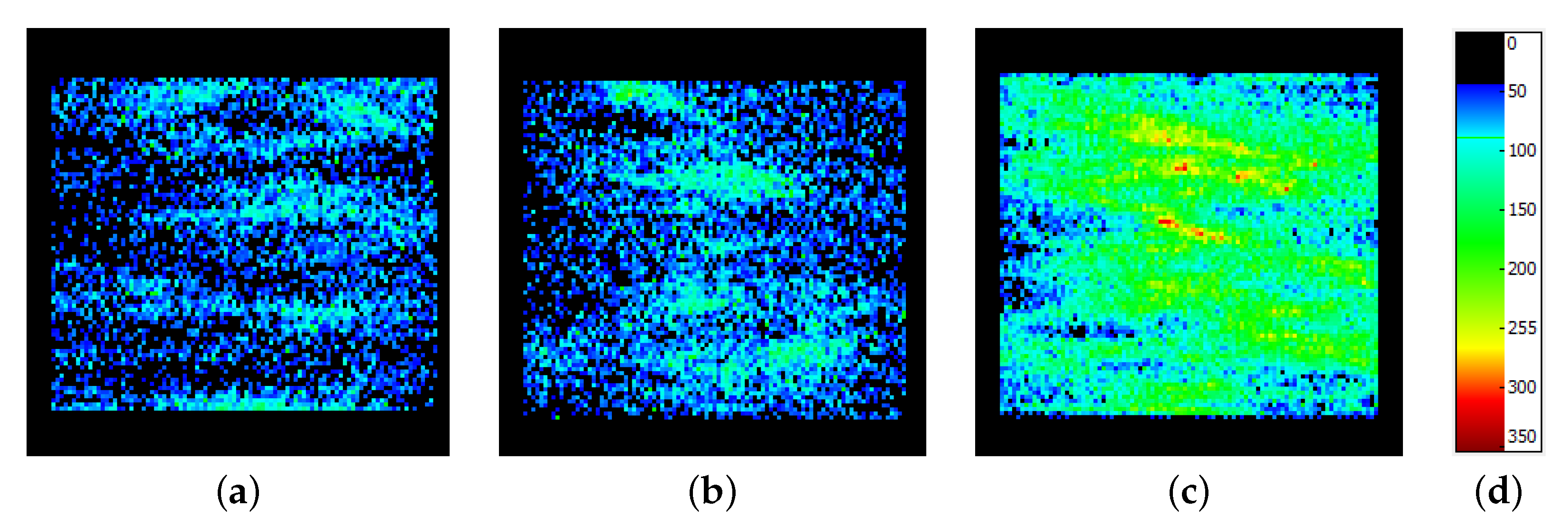
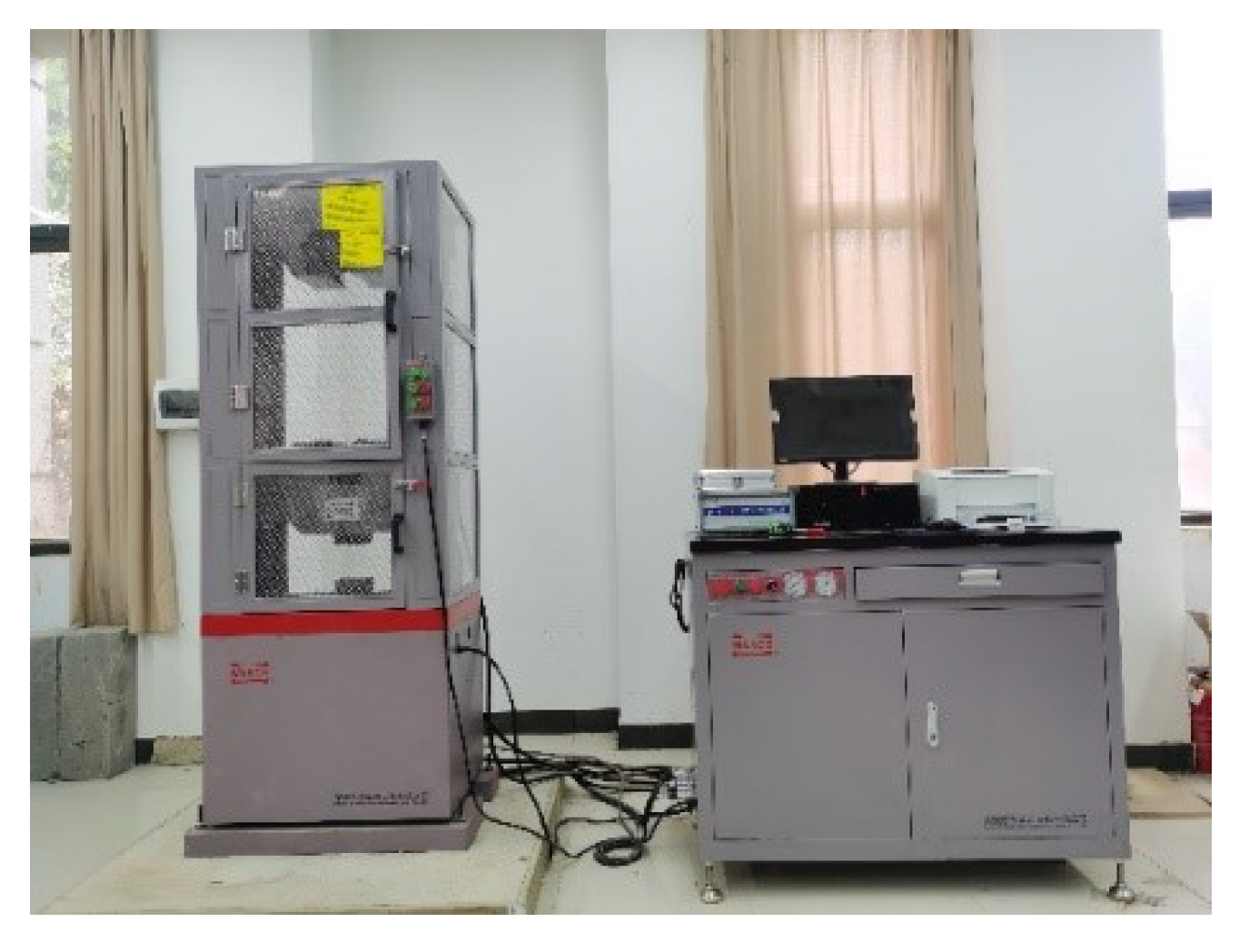
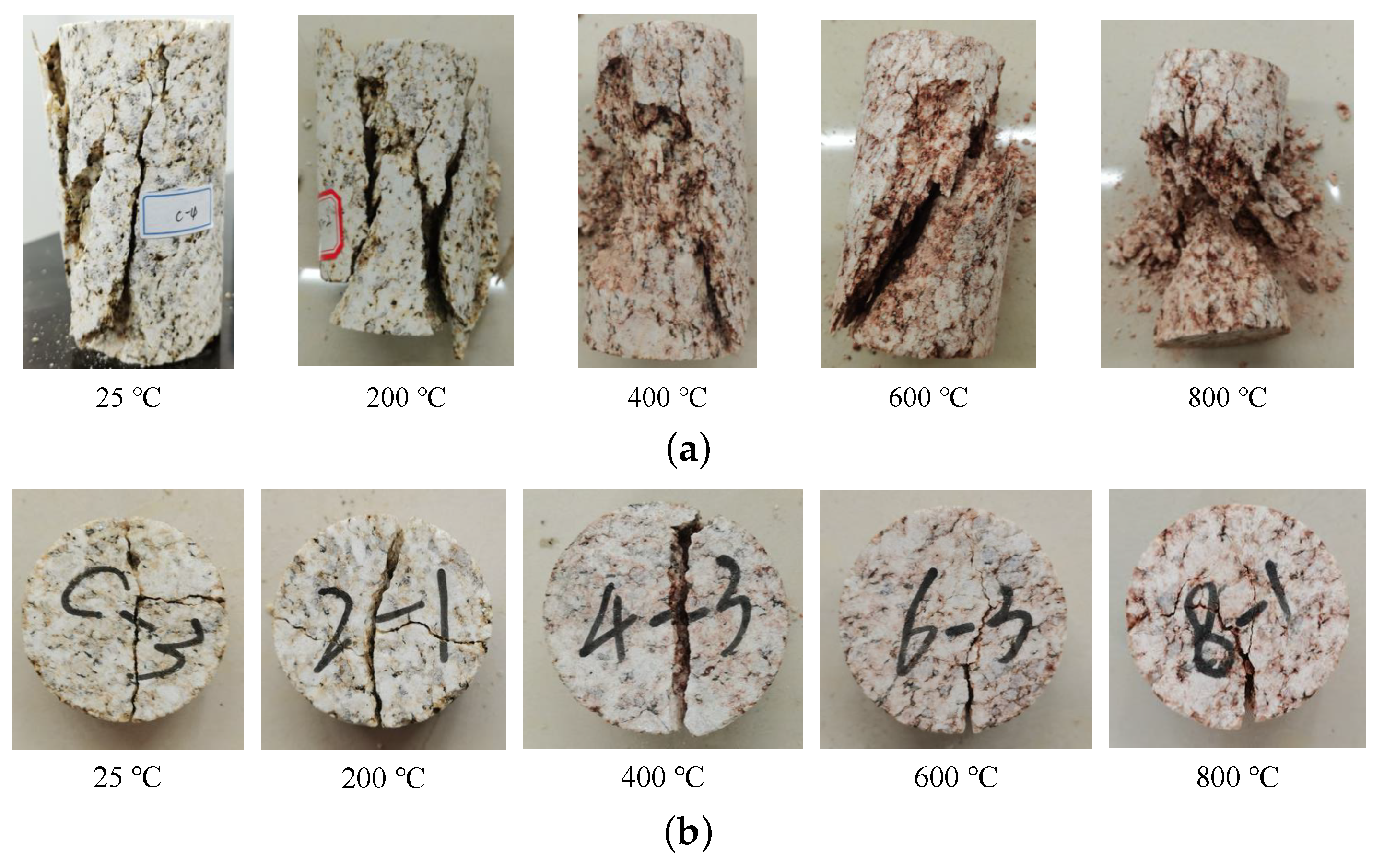
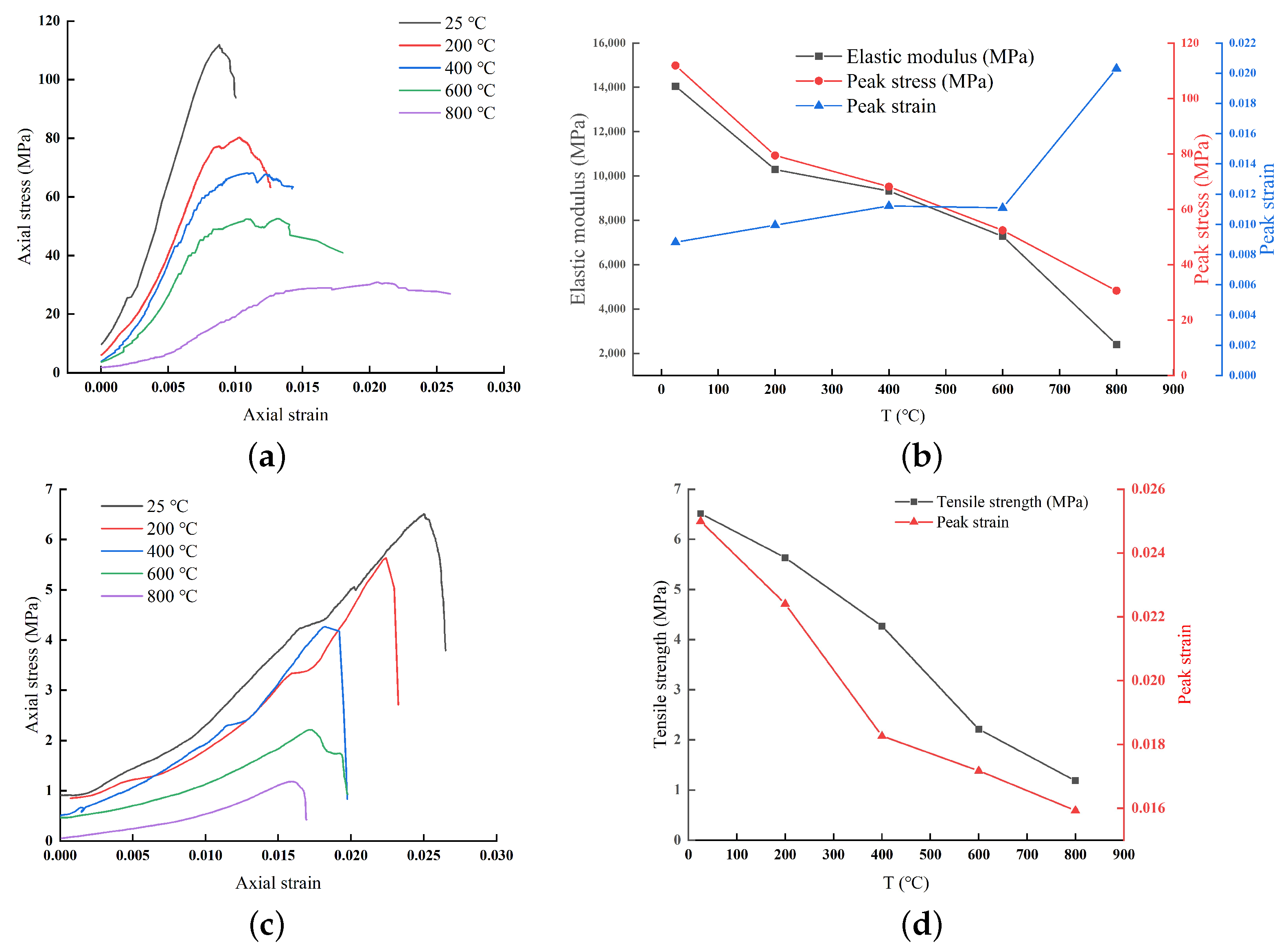

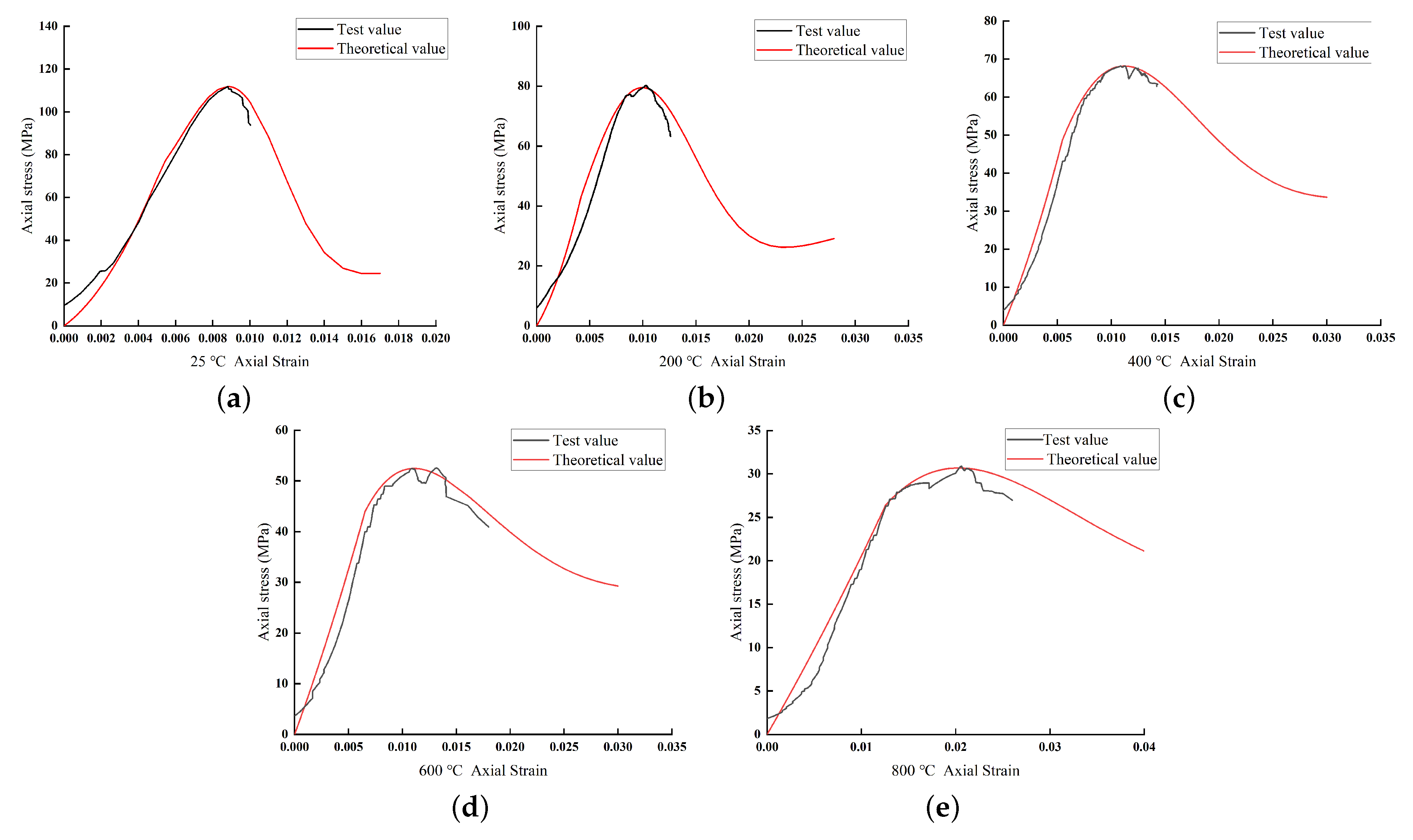
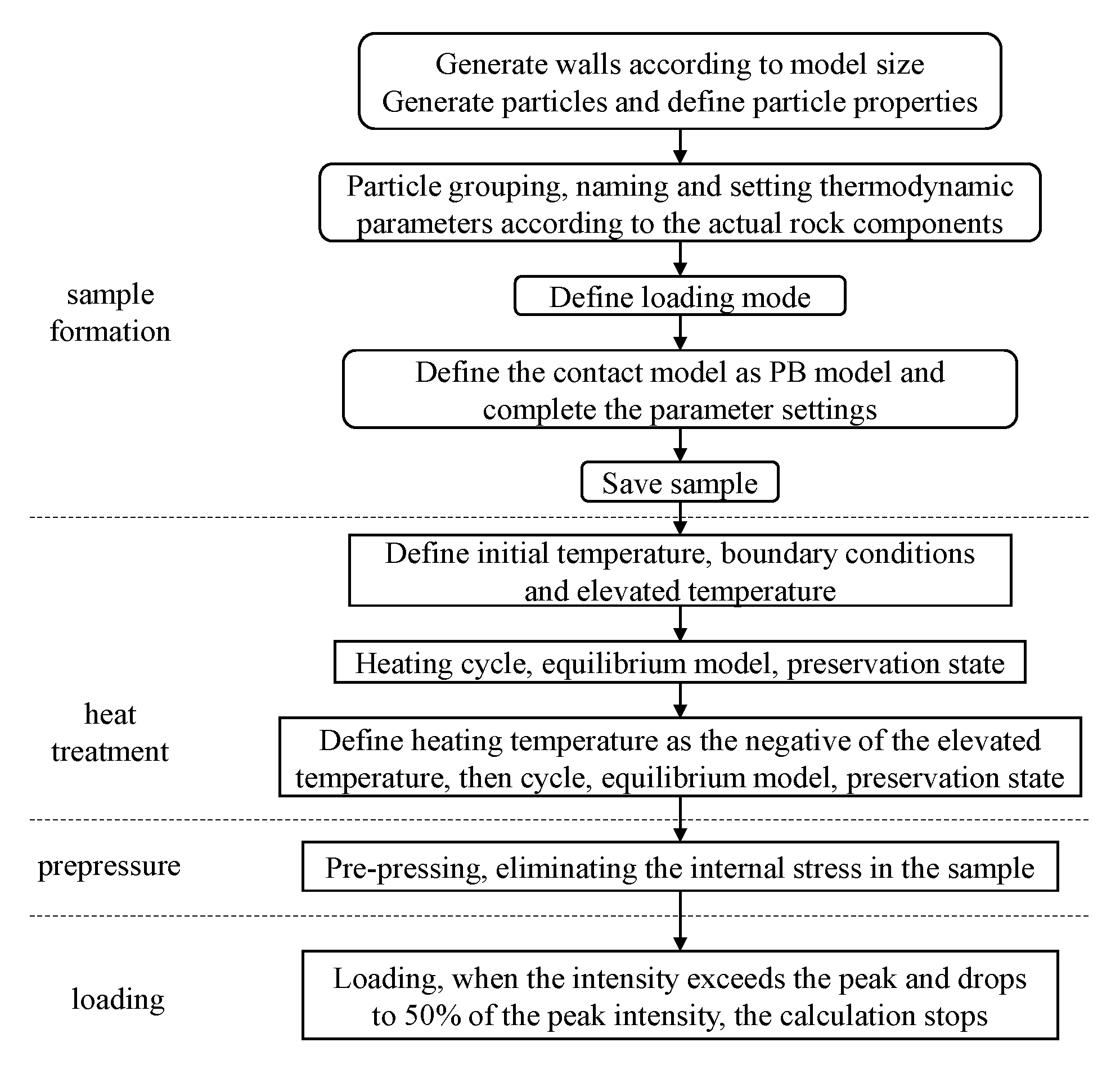


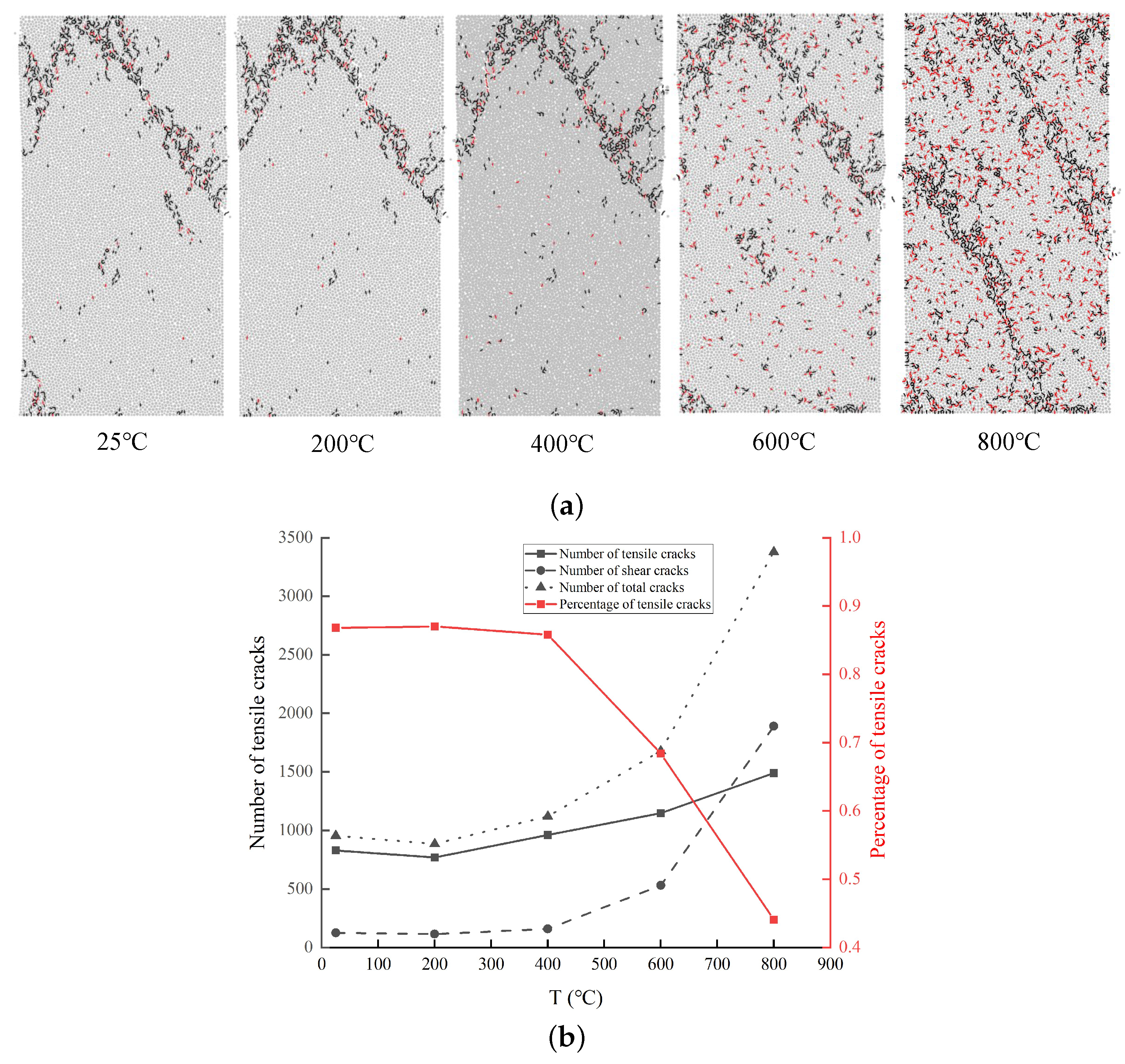
| C | |||||||
|---|---|---|---|---|---|---|---|
| 25 | 14,051.58 | 111.8710 | 0.00882 | 44.7484 | 0.00376 | 2.8669 | 47.36 |
| 200 | 10,290.00 | 79.4000 | 0.00995 | 31.7600 | 0.00417 | 1.5620 | 52.86 |
| 400 | 9322.24 | 68.1520 | 0.01122 | 27.2608 | 0.00572 | 1.1271 | 52.20 |
| 600 | 7280.79 | 52.3744 | 0.01109 | 20.9498 | 0.00651 | 0.8726 | 53.29 |
| 800 | 2402.92 | 30.5807 | 0.02031 | 12.2323 | 0.01252 | 0.6921 | 50.87 |
| C | K | m | A | B | |
|---|---|---|---|---|---|
| 25 | 0.00000 | 38.1773 | 2.709271 | 1,490,249.16 | 6318.17 |
| 200 | 0.26770 | 75.7117 | 2.328035 | 1,045,909.61 | 5939.64 |
| 400 | 0.33657 | 94.5893 | 1.671817 | 337,823.69 | 6882.43 |
| 600 | 0.48185 | 47.8525 | 1.380419 | 140,391.48 | 5815.79 |
| 800 | 0.82899 | 37.5851 | 1.484007 | 17,505.03 | 1881.04 |
| Category | Parameter | Unit | Value |
|---|---|---|---|
| Particle | Minimum particle size | m | 6 × 10 |
| Max/min particle size ratio | - | 1.66 | |
| Density | kg/cm | 2.564 | |
| Elastic modulus | Pa | 1.4 × 10 | |
| Friction coefficient | - | 0.5 | |
| Stiffness ratio | - | 1 | |
| Contact | Bonding tensile strength | Pa | 1 × 10 |
| Gluing adhesion | Pa | 1 × 10 | |
| Gluing friction angle | ° | 47.36 | |
| Friction coefficient | - | 0.5 | |
| Radius multiplier | - | 1 | |
| Normal to tangential stiffness ratio | - | 1 | |
| Stiffness ratio | - | 1 |
| Mineral | Linear Coefficient of Thermal Expansion /10·C | Thermal Conductivity /W·Mk | Specific Heat Capacity /J·kg C |
|---|---|---|---|
| Feldspar | 15 | 2 × 10 | 800 |
| Quartz | 10 | 2 × 10 | 800 |
| Mica | 3.5 | 2 × 10 | 800 |
Disclaimer/Publisher’s Note: The statements, opinions and data contained in all publications are solely those of the individual author(s) and contributor(s) and not of MDPI and/or the editor(s). MDPI and/or the editor(s) disclaim responsibility for any injury to people or property resulting from any ideas, methods, instructions or products referred to in the content. |
© 2022 by the authors. Licensee MDPI, Basel, Switzerland. This article is an open access article distributed under the terms and conditions of the Creative Commons Attribution (CC BY) license (https://creativecommons.org/licenses/by/4.0/).
Share and Cite
Zhang, X.; Wei, M.; Lei, Z.; Chen, Y. A Multi-Scale Study on the Property Degradation of High-Temperature Treated Beishan Granite. Minerals 2023, 13, 27. https://doi.org/10.3390/min13010027
Zhang X, Wei M, Lei Z, Chen Y. A Multi-Scale Study on the Property Degradation of High-Temperature Treated Beishan Granite. Minerals. 2023; 13(1):27. https://doi.org/10.3390/min13010027
Chicago/Turabian StyleZhang, Xiang, Manke Wei, Zhen Lei, and Ying Chen. 2023. "A Multi-Scale Study on the Property Degradation of High-Temperature Treated Beishan Granite" Minerals 13, no. 1: 27. https://doi.org/10.3390/min13010027
APA StyleZhang, X., Wei, M., Lei, Z., & Chen, Y. (2023). A Multi-Scale Study on the Property Degradation of High-Temperature Treated Beishan Granite. Minerals, 13(1), 27. https://doi.org/10.3390/min13010027





